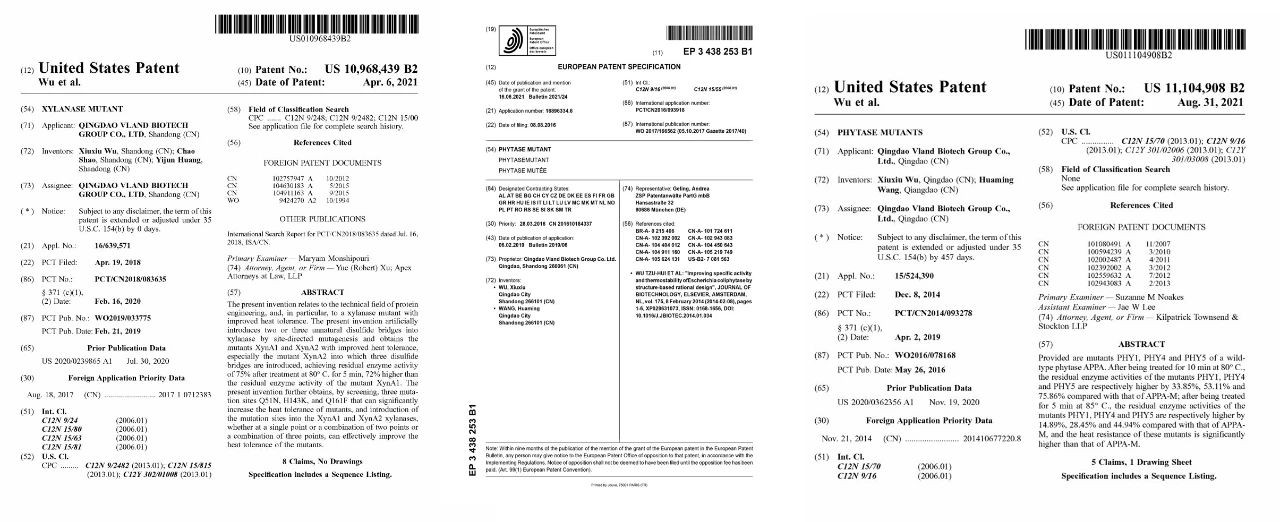Vland Obtains Authorized US and European Patents of Feed Phytase and Xylanase

Qingdao Vland Biotech Group Co., Ltd., a subsidiary of Qingdao Vland Biotech Inc., has recently been granted US and European patents of heat-resistant phytase (Publication No. US11104908 and EP3438253). Its patent of heat-resistant xylanase has also been authorized in the United States (Publication No. US10968439). Phytase and xylanase are two kinds of enzymes which are widely used in animal feed.
Technological innovation is the core driver for Vland’s development. With the philosophy of self-innovation in mind, Vland has been improving its technologies to increase product quality, optimize product mix and reduce production costs. In accordance with the Semi-Annual Report, Vland invested RMB 46.692 million (or USD 7.23 million) in R&D in the first half year, a figure accounting for 8.50% of the operating income and representing a relatively high level in the industry.
Continuous large-scale R&D investment helps Vland develop a range of cutting-edge patented technologies, injecting strong growth momentum into its operations. Until now, Vland has established 8 technology centers, 2 labs and 9 nation-level innovation platforms. It has been focusing on the work of “from lab to market” with the market as the orientation, development of new products and technologies as the goal and application development as the bond.
While attaching great importance to research and development, Vland places a high value on the protection of intellectual property rights. In 2011, Vland established the Intellectual Property Management Department joined by a team of professional patent agents and patent engineers to advance the comprehensive IPR protection for R&D results. Meanwhile, the department takes active part in the application of overseas patents, continuously strengthens the risk management and control of R&D process and products, and designs a forward-looking plan of core technology patents. In the first half of 2021, Vland obtained 12 new authorized Chinese invention patents, 1 new authorized US patent, 2 new authorized European patents and 5 new PCT applications. As of the end of the reporting period, the company and its subsidiaries owned 264 authorized Chinese invention patents, 6 US authorized patents, 2 European authorized patents and 20 PCT applications.
Vland has long been committed to the construction of technological innovation system and respects international rules and intellectual property rights. A complete core technology system with independent intellectual property rights has been formed and thus platform competitiveness increased. Vland has established extensive cooperation relationship with international businesses including industrial giants.
Based on the advantages of Vland Enzyme Platform, the R&D project carried out by Vland-ADM Joint Laboratory has made substantial progress and achieved a milestone. ADM, a Fortune 500 enterprise, has thus made new effective inputs into the joint research in accordance with the agreement. The two parties take this deeper cooperation as an opportunity to develop new enzyme products. In March 2021, Vland and ADM signed an agreement on the cooperation of the highland barley project. The two sides will make full use of their respective technological and market advantages to conduct cooperation in production process and application development, realizing the use of highland barley in the whole chain of food and beverage industries.
Regrading probiotics, Vland and Evonik have further deepened their cooperation and a smooth progress has been made in the aquaculture project. After about two years of joint research and development, Vland and Evonik have successfully launched an innovative probiotic additive product that can improve the water quality for shrimp farming. Jointly developed by both parties, the product is expected to be launched on the Chinese market at the end of 2021 with Vland as the manufacturer and Evonik as the exclusive seller. This whole-new additive can break down toxic compounds to improve water quality, maintain animal health and reduce the environmental impact caused by frequent water changes.


 Add.:
Add.:  Tel.: +86 532 88969585
Tel.: +86 532 88969585 Email: kdn@vlandgroup.com
Email: kdn@vlandgroup.com